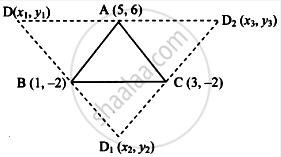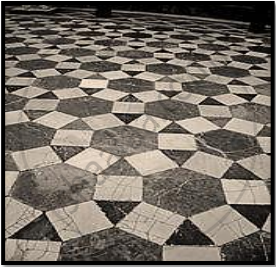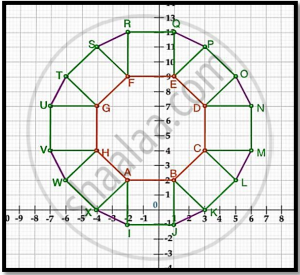Advertisements
Advertisements
Question
Find the possible pairs of coordinates of the fourth vertex D of the parallelogram, if three of its vertices are A(5, 6), B(1, –2) and C(3, –2).
Solution 1

ABCD is a parallelogram.
∴ AD = BC and CD = AB ...(Opposite sides of the parallelogram is congruent.)
∴ AD = BC
∴ `sqrt((a - 5)^2 + (b - 6)^2) = sqrt((3 - 1)^2 + [- 2 - (-2)]^2)` ...(Distance Formula)
Squaring bothe the sides,
∴ (a - 5)2 + (b - 6)2 = (3 - 1)2 + (- 2 + 2)2
∴ a2 - 10a + 25 + b2 - 12b + 36 = 4 + 0
∴ a2 + b2 - 10a - 12b + 57 = 0 ...(I)
∴ CD = AB
`∴ sqrt((a - 3)^2 + [b - (- 2)]^2) = sqrt((5 - 1)^2 + [6 - (-2)]^2)` ...(Distance Formula)
Squaring bothe the sides,
∴ (a - 3)2 + (b + 2)2 = (5 - 1)2 + (6 + 2)2
∴ a2 - 6a + 9 + b2 + 4b + 4 = 16 + 64
∴ a2 - 6a + b2 + 4b = 80 - 9 - 4
∴ a2 + b2 - 6a + 4b - 67 = 0 ...(II)
Point D lies on the line passing through the point A. So, the ordinate of the point D will also be same as that of point A which is 6. So, b = 6.
Putting the value of b in (I), we get,
a2 + 62 - 10a - 12 × 6 + 57 = 0
a2 + 36 - 10a - 72 + 57 = 0
a2 - 10a - 21 = 0
a2 - 7a - 3a + 21 = 0
a(a - 7) - 3(a - 7) = 0
(a - 7)(a - 3) = 0
a = 3, 7
Thus, the possible values of point D are (3, 6) and (7, 6).
Solution 2

Let the points A(5, 6), B(1, -2) and C(3, -2) be the three vertices of a parallelogram.
The fourth vertex can be point D or point D1 or point D2 as shown in the figure.
Let D(x1, y1), D1(x2, y2) and D2(x3, y3).
Consider the parallelogram ACBD.
The diagonals of a parallelogram bisect each other.
∴ midpoint of DC = midpoint of AB
`∴ ((x_1 + 3)/2, (y_1 - 2)/2) = ((5 + 1)/2, (6 - 2)/2)`
`∴ ((x_1 + 3)/2, (y_1 - 2)/2) = (6/2, 4/2)`
`∴ (x_1 + 3)/2 = 6/2 and (y_1 - 2)/2 = 4/2`
∴ x1 + 3 = 6 and y1 - 2 = 4
∴ x1 = 3 and y1 = 6
Co-ordinates of point D(x1, y1) are (3, 6).
Consider the parallelogram ABD1C.
The diagonals of a parallelogram bisect each other.
∴ midpoint of AD1 = midpoint of BC
`∴ ((x_2 + 5)/2, (y_2 + 6)/2) = ((3 + 1)/2, (-2 - 2)/2)`
`∴ ((x_2 + 5)/2, (y_2 + 6)/2) = (4/2, (-4)/2)`
`∴ (x_2 + 5)/2 = 4/2 and (y_2 + 6)/2 = (-4)/2`
∴ x2 + 5 = 4 and y2 + 6 = -4
∴ x2 = - 1 and y2 = - 10
∴ Co-ordinates of D (x2, y2) are (-1,-10).
Consider the parallelogram ABCD2.
The diagonals of a parallelogram bisect each other.
∴ midpoint of BD2 = midpoint of AC
`∴ ((x_3 + 1)/2, (y_3 - 2)/2) = ((5 + 3)/2, (6 - 2)/2)`
`∴ ((x_3 + 1)/2, (y_3 - 2)/2) = (8/2, 4/2)`
`∴ (x_3 + 1)/2 = 8/2 and (y_3 - 2)/2 = 4/2`
∴ x3 + 1 = 8 and y3 - 2 = 4
∴ x3 = 7 and y3 = 6
∴ co-ordinates of point D2(x3 , y3) are (7, 6).
∴ The possible pairs of co-ordinates of the fourth vertex D of the parallelogram are (3, 6), (-1, -10) and (7, 6).
APPEARS IN
RELATED QUESTIONS
Prove that the points (3, 0), (6, 4) and (-1, 3) are the vertices of a right-angled isosceles triangle.
Let ABCD be a square of side 2a. Find the coordinates of the vertices of this square when The centre of the square is at the origin and coordinate axes are parallel to the sides AB and AD respectively.
Which point on the x-axis is equidistant from (5, 9) and (−4, 6)?
Find a point on y-axis which is equidistant from the points (5, -2) and (-3, 2).
Find the points of trisection of the line segment joining the points:
(3, -2) and (-3, -4)
Find the points on the y-axis which is equidistant form the points A(6,5) and B(- 4,3)
Find the coordinates of the midpoints of the line segment joining
P(-11,-8) and Q(8,-2)
Find the area of a quadrilateral ABCD whose vertices area A(3, -1), B(9, -5) C(14, 0) and D(9, 19).
Find the area of quadrilateral ABCD whose vertices are A(-3, -1), B(-2,-4) C(4,-1) and D(3,4)
Find the ratio in which the line segment joining the points A(3, 8) and B(–9, 3) is divided by the Y– axis.
Find the coordinates of circumcentre and radius of circumcircle of ∆ABC if A(7, 1), B(3, 5) and C(2, 0) are given.
What is the distance between the points (5 sin 60°, 0) and (0, 5 sin 30°)?
Write the formula for the area of the triangle having its vertices at (x1, y1), (x2, y2) and (x3, y3).
If the area of the triangle formed by the points (x, 2x), (−2, 6) and (3, 1) is 5 square units , then x =
The length of a line segment joining A (2, −3) and B is 10 units. If the abscissa of B is 10 units, then its ordinates can be
Point (–3, 5) lies in the ______.
The points (–5, 2) and (2, –5) lie in the ______.
The perpendicular distance of the point P(3, 4) from the y-axis is ______.
Seg AB is parallel to X-axis and coordinates of the point A are (1, 3), then the coordinates of the point B can be ______.
A tiling or tessellation of a flat surface is the covering of a plane using one or more geometric shapes, called tiles, with no overlaps and no gaps. Historically, tessellations were used in ancient Rome and in Islamic art. You may find tessellation patterns on floors, walls, paintings etc. Shown below is a tiled floor in the archaeological Museum of Seville, made using squares, triangles and hexagons.

A craftsman thought of making a floor pattern after being inspired by the above design. To ensure accuracy in his work, he made the pattern on the Cartesian plane. He used regular octagons, squares and triangles for his floor tessellation pattern

Use the above figure to answer the questions that follow:
- What is the length of the line segment joining points B and F?
- The centre ‘Z’ of the figure will be the point of intersection of the diagonals of quadrilateral WXOP. Then what are the coordinates of Z?
- What are the coordinates of the point on y-axis equidistant from A and G?
OR
What is the area of Trapezium AFGH?
